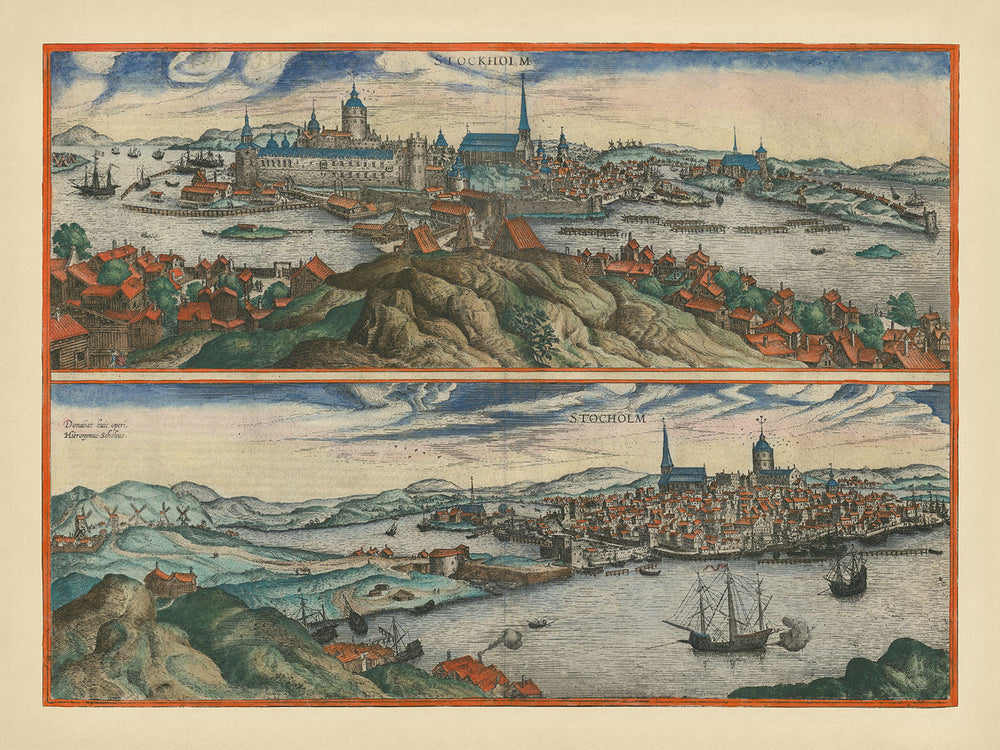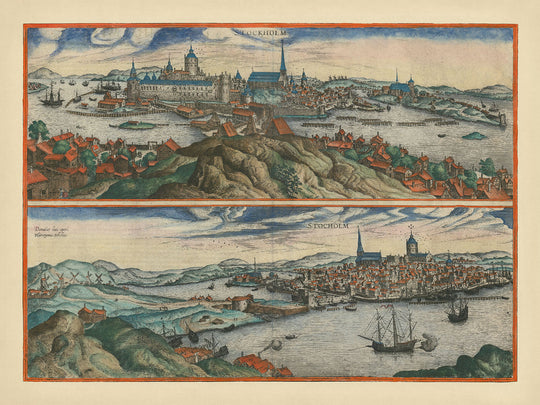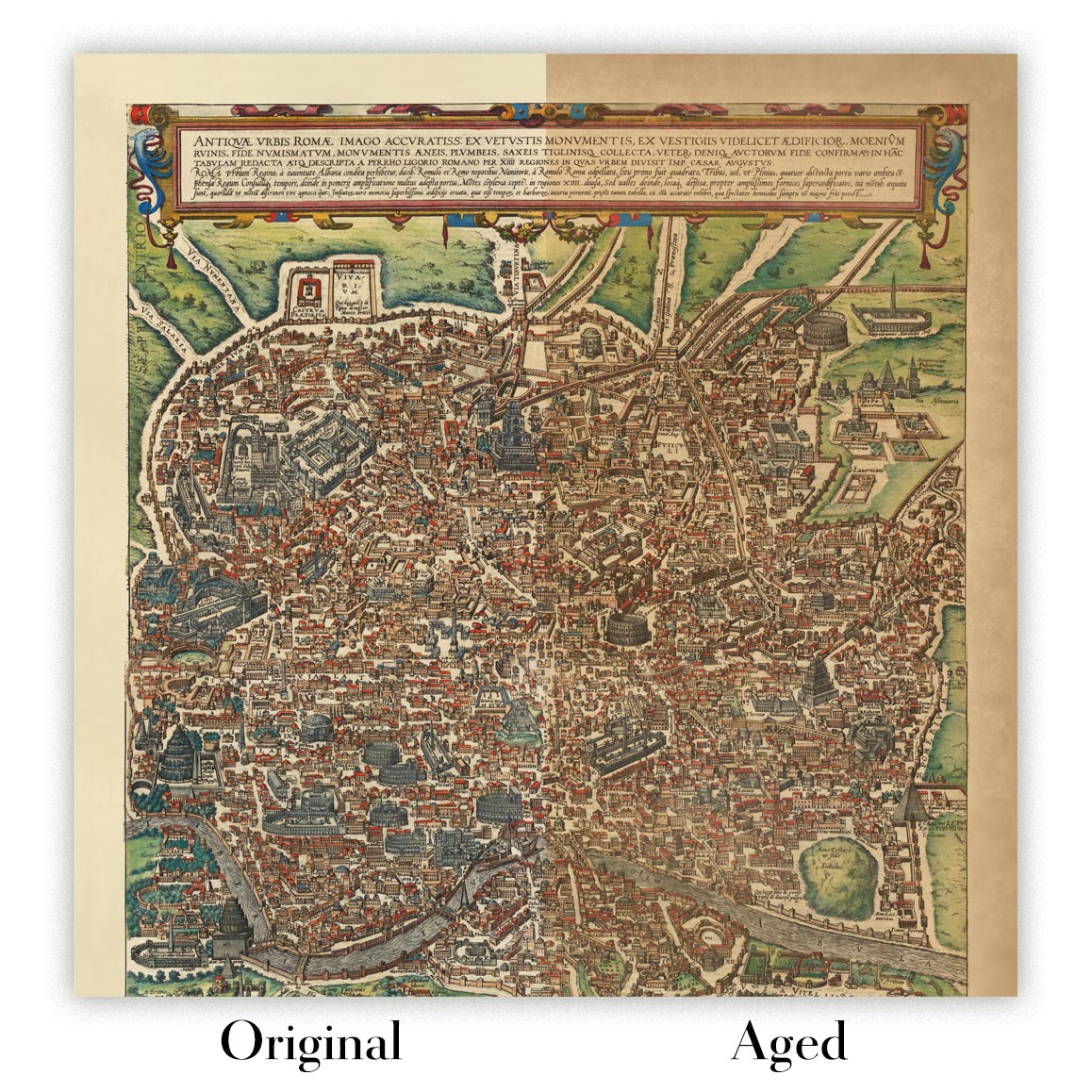- Handmade locally. No import duty or tax
- FREE Delivery by Christmas
- Love it or your money back (90 days)
- Questions? WhatsApp me any time
Own a piece of history
5,000+ 5 star reviews


Behold the exquisite "Stockholm / Stocholm" map, crafted in 1599 by the illustrious Georg Braun and Frans Hogenberg. This bird’s-eye view map offers a captivating glimpse into the urban landscape of Stockholm during the late 16th century. As part of the renowned Civitates Orbis Terrarum atlas, this map captures the essence of Stockholm's intricate network of waterways, bustling with ships and boats, underscoring the city's reliance on water transport. The detailed illustrations of the city's architecture, including the prominent Royal Palace, transport the viewer back to a time when Stockholm was emerging as a significant European capital.
Stockholm, situated at the mouth of Lake Mälaren, is beautifully depicted with its series of islands and peninsulas. The map highlights the city's complex network of canals and bridges, which were vital for trade and transportation. The abundance of water surrounding the city is a testament to its strategic location and economic prowess. The bustling waterways, teeming with vessels, reflect the city's vibrant maritime activities and its importance as a hub of commerce and culture.
The architectural grandeur of Stockholm is meticulously illustrated in this map, with the Royal Palace standing as a focal point. The palace, with its intricate façade, towers, and courtyards, dominates the western part of the city, symbolizing the power and prestige of the Swedish monarchy. Other notable buildings, including churches and public edifices, are depicted in great detail, showcasing the city's rich architectural heritage. This map serves as a visual record of Stockholm's urban development and its architectural marvels during the late Renaissance period.
The surrounding hills and natural landscapes add a picturesque quality to the map, providing a stark contrast to the densely built urban areas. The depiction of green spaces and rolling hills offers a glimpse into the natural beauty that enveloped the city. This harmonious blend of urban and natural elements is a reminder of Stockholm's unique geographical setting and its harmonious coexistence with nature. The map's detailed illustrations of the city's environs provide a comprehensive view of Stockholm's topography and its integration with the surrounding landscape.
As part of the Civitates Orbis Terrarum, the greatest city book of its time, this map of Stockholm is not just a geographical representation but a historical document that offers invaluable insights into the urban life of the late 16th century. The collaborative efforts of over 100 artists and topographers, including the notable Joris Hoefnagel, have resulted in a masterpiece that captures the essence of early modern cities. This map is a testament to the artistic and cartographic excellence of Braun and Hogenberg, making it a prized possession for any connoisseur of historical maps.
Streets and roads on this map
The map does not have clearly labeled streets or roads that can be identified with certainty. Therefore, no streets or roads can be listed.
Notable Features & Landmarks
- Illustrations:
- Detailed depictions of buildings, ships, and natural landscapes.
- Landmarks:
- The Royal Palace
- Prominent churches
- Public buildings
- Lakes and waterways:
- Numerous canals and waterways
- Lake Mälaren
- Other notable features:
- Various ships and boats navigating the waters around the city.
- Surrounding hills and natural landscapes.
Historical and design context
- Name of the map: Stockholm / Stocholm
- Creation date: 1599
- Mapmaker or publisher: Georg Braun & Frans Hogenberg
-
Interesting context about the mapmakers:
- Georg Braun and Frans Hogenberg began creating a comprehensive atlas of world cities in 1572, named Civitates Orbis Terrarum.
- The atlas was intended as a companion to Abraham Ortelius's Theatrum Orbis Terrarum, the first true atlas.
- The series contains over 546 views, with contributions from over 100 artists and topographers, notably Joris Hoefnagel.
- Topics and themes shown on the map:
- Urban landscape: Detailed depiction of Stockholm's buildings, streets, and waterways.
- Waterways and transport: Emphasis on Stockholm's network of canals, waterways, and bridges, highlighting the importance of water transport.
- Architecture: Detailed representation of important buildings like the Royal Palace.
- Countries and regions shown on the map: The map focuses on the city of Stockholm, Sweden.
- Design or style of the map:
- Bird’s-eye view: The map provides a pair of bird’s-eye views of Stockholm.
- Pictorial elements: Illustrations of buildings, ships, and natural features.
- Historical significance or context:
- The map provides an invaluable insight into the urban life of Stockholm in the late 16th century.
- It is part of Civitates Orbis Terrarum, which is a crucial source for understanding early modern urban landscapes.
Please double check the images to make sure that a specific town or place is shown on this map. You can also get in touch and ask us to check the map for you.
This map looks great at every size, but I always recommend going for a larger size if you have space. That way you can easily make out all of the details.
This map looks amazing at sizes all the way up to 70in (180cm). If you are looking for a larger map, please get in touch.
The model in the listing images is holding the 18x24in (45x60cm) version of this map.
The fifth listing image shows an example of my map personalisation service.
If you’re looking for something slightly different, check out my collection of the best old maps to see if something else catches your eye.
Please contact me to check if a certain location, landmark or feature is shown on this map.
This would make a wonderful birthday, Christmas, Father's Day, work leaving, anniversary or housewarming gift for someone from the areas covered by this map.
This map is available as a giclée print on acid free archival matte paper, or you can buy it framed. The frame is a nice, simple black frame that suits most aesthetics. Please get in touch if you'd like a different frame colour or material. My frames are glazed with super-clear museum-grade acrylic (perspex/acrylite), which is significantly less reflective than glass, safer, and will always arrive in perfect condition.
This map is also available as a float framed canvas, sometimes known as a shadow gap framed canvas or canvas floater. The map is printed on artist's cotton canvas and then stretched over a handmade box frame. We then "float" the canvas inside a wooden frame, which is available in a range of colours (black, dark brown, oak, antique gold and white). This is a wonderful way to present a map without glazing in front. See some examples of float framed canvas maps and explore the differences between my different finishes.
For something truly unique, this map is also available in "Unique 3D", our trademarked process that dramatically transforms the map so that it has a wonderful sense of depth. We combine the original map with detailed topography and elevation data, so that mountains and the terrain really "pop". For more info and examples of 3D maps, check my Unique 3D page.
For most orders, delivery time is about 3 working days. Personalised and customised products take longer, as I have to do the personalisation and send it to you for approval, which usually takes 1 or 2 days.
Please note that very large framed orders usually take longer to make and deliver.
If you need your order to arrive by a certain date, please contact me before you order so that we can find the best way of making sure you get your order in time.
I print and frame maps and artwork in 23 countries around the world. This means your order will be made locally, which cuts down on delivery time and ensures that it won't be damaged during delivery. You'll never pay customs or import duty, and we'll put less CO2 into the air.
All of my maps and art prints are well packaged and sent in a rugged tube if unframed, or surrounded by foam if framed.
I try to send out all orders within 1 or 2 days of receiving your order, though some products (like face masks, mugs and tote bags) can take longer to make.
If you select Express Delivery at checkout your order we will prioritise your order and send it out by 1-day courier (Fedex, DHL, UPS, Parcelforce).
Next Day delivery is also available in some countries (US, UK, Singapore, UAE) but please try to order early in the day so that we can get it sent out on time.
My standard frame is a gallery style black ash hardwood frame. It is simple and quite modern looking. My standard frame is around 20mm (0.8in) wide.
I use super-clear acrylic (perspex/acrylite) for the frame glass. It's lighter and safer than glass - and it looks better, as the reflectivity is lower.
Six standard frame colours are available for free (black, dark brown, dark grey, oak, white and antique gold). Custom framing and mounting/matting is available if you're looking for something else.
Most maps, art and illustrations are also available as a framed canvas. We use matte (not shiny) cotton canvas, stretch it over a sustainably sourced box wood frame, and then 'float' the piece within a wood frame. The end result is quite beautiful, and there's no glazing to get in the way.
All frames are provided "ready to hang", with either a string or brackets on the back. Very large frames will have heavy duty hanging plates and/or a mounting baton. If you have any questions, please get in touch.
See some examples of my framed maps and framed canvas maps.
Alternatively, I can also supply old maps and artwork on canvas, foam board, cotton rag and other materials.
If you want to frame your map or artwork yourself, please read my size guide first.
My maps are extremely high quality reproductions of original maps.
I source original, rare maps from libraries, auction houses and private collections around the world, restore them at my London workshop, and then use specialist giclée inks and printers to create beautiful maps that look even better than the original.
My maps are printed on acid-free archival matte (not glossy) paper that feels very high quality and almost like card. In technical terms the paper weight/thickness is 10mil/200gsm. It's perfect for framing.
I print with Epson ultrachrome giclée UV fade resistant pigment inks - some of the best inks you can find.
I can also make maps on canvas, cotton rag and other exotic materials.
Learn more about The Unique Maps Co.
Map personalisation
If you're looking for the perfect anniversary or housewarming gift, I can personalise your map to make it truly unique. For example, I can add a short message, or highlight an important location, or add your family's coat of arms.
The options are almost infinite. Please see my map personalisation page for some wonderful examples of what's possible.
To order a personalised map, select "personalise your map" before adding it to your basket.
Get in touch if you're looking for more complex customisations and personalisations.
Map ageing
I have been asked hundreds of times over the years by customers if they could buy a map that looks even older.
Well, now you can, by selecting Aged before you add a map to your basket.
All the product photos you see on this page show the map in its Original form. This is what the map looks like today.
If you select Aged, I will age your map by hand, using a special and unique process developed through years of studying old maps, talking to researchers to understand the chemistry of aging paper, and of course... lots of practice!
If you're unsure, stick to the Original colour of the map. If you want something a bit darker and older looking, go for Aged.
If you are not happy with your order for any reason, contact me and I'll get it fixed ASAP, free of charge. Please see my returns and refund policy for more information.
I am very confident you will like your restored map or art print. I have been doing this since 1984. I'm a 5-star Etsy seller. I have sold tens of thousands of maps and art prints and have over 5,000 real 5-star reviews. My work has been featured in interior design magazines, on the BBC, and on the walls of dozens of 5-star hotels.
I use a unique process to restore maps and artwork that is massively time consuming and labour intensive. Hunting down the original maps and illustrations can take months. I use state of the art and eye-wateringly expensive technology to scan and restore them. As a result, I guarantee my maps and art prints are a cut above the rest. I stand by my products and will always make sure you're 100% happy with what you receive.
Almost all of my maps and art prints look amazing at large sizes (200cm, 6.5ft+) and I can frame and deliver them to you as well, via special oversized courier. Contact me to discuss your specific needs.
Or try searching for something!
















































